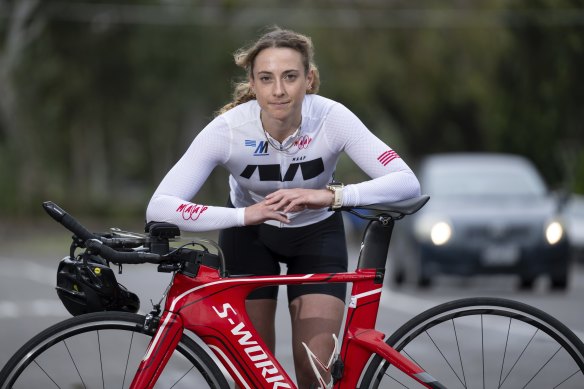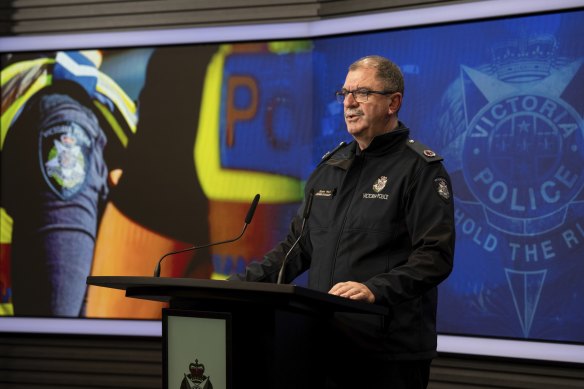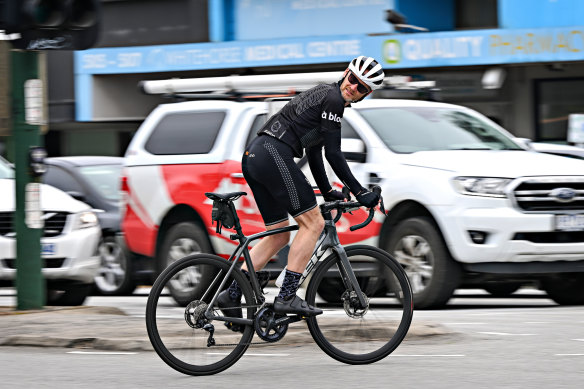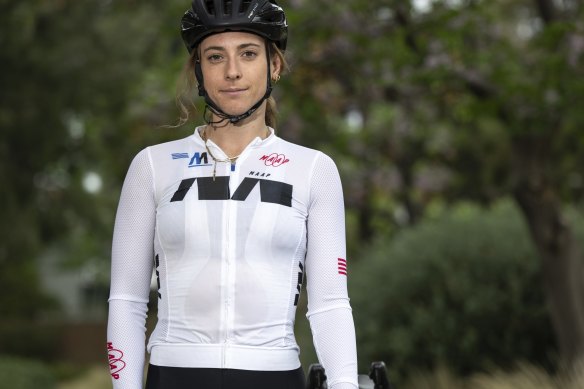
Save articles for later
Add articles to your saved list and come back to them any time.
It’s the thought of the phone call to her family that worries Ciara Boyd-Squires Long. The avid bike rider, and teacher, thinks of “my poor mum, getting a phone call like, ‘your daughter’s in hospital’.”
Long believes that drivers are more aggressive, abusive and less patient since the pandemic, which has “been very scary; especially when you do everything you can to be safe”. She had two lucky escapes recently – in late September and early October.
Bike rider Ciara Boyd-Squires Long says drivers are more aggressive since the pandemic: “Every time you go out on a ride, you get abused”.Credit: Penny Stephens
A few weeks ago, Long and her mates were riding along Nepean Highway at 9am when a car came out of a side-street and T-boned them.
“I was knocked off my bike, was unconscious, had a concussion, my bike’s been written off,” says Long, a member of cycling advocacy group, Bicycle Network. “The driver apparently ‘didn’t see us’, but it was broad daylight, we were in bright clothing, there is absolutely no way we couldn’t be seen.”
Like police, tram and bus drivers and hundreds of other Victorians who wrote to the Legislative Assembly’s 2023 inquiry into how road behaviours have changed, Long says the mood is tetchier. But, like the experts, she is not sure what is behind it.
Frightening experiences
The first half of 2023 was the deadliest in more than a decade in Victoria, and the equal deadliest in 18 years.
Lives lost are at a 15-year-high.
As of October 26, 236 people had died compared with 201 deaths in the same period in 2022 (16.8 per cent higher). Deaths are also up in NSW, where, as of Thursday, there were 295 lives lost, compared with 227 at this time last year.
Police say minor errors, lack of consideration and recklessness are causes and, since the pandemic, there is less compliance with basic road laws.
Drivers are more prone to “low-level rule breaking”, Victoria’s chief of road policing, Assistant Commissioner Glenn Weir says, noting “normally good people making one-off dumb mistakes” is largely to blame for more than half this year’s fatalities.
“It’s not high-end hoon driving, it’s low-range speeding, lower level drink-driving, simple things like going through stop signs or give way signs, and distractions.”
Data to explain what’s behind this is not available, but anecdotal evidence of more irritability and riskier choices is easy to find. In 299 submissions to the Victorian inquiry, themes such as drivers shooting through red lights at crossings, hitting cyclists, watching TikTok or YouTube on mounted phones and being more aggressive, came up often.
Rory Dickson, a father of two young children, told the inquiry that on walks to school, which require crossing Pascoe Vale Road, drivers seem more impatient and distracted: “We have had some frightening experiences. From road-rage to near misses at pedestrian crossings,” he said.
In February, they were waiting at a crossing near the primary school when “a driver started to slow and come to a stop – my kids were about to walk as the light had turned green for pedestrians, but a vehicle overtook the slowing vehicle and blasted through the red light.
“If my child decided to run across the road, they would be dead. There are examples where something similar like this happens weekly to me. For it to be occurring weekly to me, this must be rampant across our state.”
Luke Adkins said he was nearly hit on pedestrian crossings with lights on several occasions: “Just this week in Kensington this has happened to me three times. Each occasion the driver did not even seem aware the light had turned red, not slowing or even speeding up to race through the lights. There was no awareness at all.”
Truck drivers such as John Williams, on the road 35 years, told the inquiry: “The standard of driving and risk taking from everyone – from car drivers to truck drivers – is incredibly concerning. Basic road rules and courtesy are being ignored.“
Assistant Commissioner Glenn Weir gave a press conference in May about the high number of road deaths in one weekend, pleading with Victorians to change their behavoir and listen to victim impact statements. In June, 16 people died on the roads in a week.Credit: Penny Stephens
The rise of ‘weird’ driving
All year, Glenn Weir has emphasised that road habits are – as he put it on 3AW after a ute tail-gaited a small car at speed and both crashed – “weird”.
“People have lost their manners, people are just in an inherent rush to get everywhere, and it seems to be people are triggered really easily and don’t actually act with civility and manners. And we see the results,” he told listeners.
Many drivers had lost patience, he told ABC radio this month, and seem to be deliberately “giving the middle finger to common sense”.
Weir has been gobsmacked by the numbers of people not wearing seatbelts caught in this year’s roll-out of smart roadside cameras. “I thought it would probably detect a lot of people using mobile phones and other devices, which it has, but I’ve been really surprised by 2700 people in July alone [detected] not wearing seatbelts,” he said.
In 19 fatal crashes this year, those who died were not wearing seatbelts. Weir said the increase in rule breaking is being seen nationally and was discussed at a recent meeting of 180 road safety experts and police.
Head of safety policy at the RACV, Sam Lynch, said the motoring group is also concerned, especially by the fact that one-third of drivers admit to using their phone illegally while driving.
But Mark Stevenson, Professor of Urban Transport and Public Health at the University of Melbourne, says data from devices in 15,000 cars shows no significant difference in speeding behaviours.
“What we’re seeing is a network that’s congested. That highlights the need to rethink our transport system,” he says. The increase in “micromobility” in the form of e-bikes and e-scooters was also a challenge for a system not built to accommodate them.
“We continually just throw more vehicles on an infrastructure that was designed and planned in the 20th century and is challenged.” While this causes frustration, it does not necessarily lead to more road deaths, he said.
Glenn Jessop rides through the same intersection he was crossing on a green light when four-wheel drive turned right in front of him, causing him to smash into the side of the car.Credit: Joe Armao
Bike rider Glenn Jessop, who rides 200 to 300 kilometres a week, says road behaviour has been palpably worse since lockdowns ended. He was crossing an intersection within one kilometre of his Mitcham home late last year, when a luxury four wheel-drive turned right in front of him without giving way. He crashed into the side of the car, writing off his bike.
“What is really concerning is the abuse you get, and the intentional intimidation,” Jessop said. “I was riding along about six months ago on a two-lane road, [and] a guy wound down the passenger window and spat on me … it’s pure anger and abuse for no reason.”
Like Ciara Long, Jessop says dangerous driving has increased since the pandemic, but, “it’s the level of aggression that strikes me, and general anger and abuse that is most unwarranted; that’s been quite noticeable.”
Driving in ‘angry goggles’
Researchers say reduced public transport use and greater car use may be causing drivers to feel traffic is worse and become more frustrated. Cost-of-living pressures may be harming mental health, remote workers are more glued to their phones and working while driving, or there may simply be more burnout.
Transport Accident Commission chief executive Tracey Slatter is aware community members and authorities are reporting an increase in poor driving, “and while we haven’t seen any empirical evidence of this, we are very concerned at the tragic increase in road deaths this year”.
Director of the Australian Association of Psychologists Inc, Carly Dober, said as well as stress, anxiety or overwhelm possibly affecting people’s driving, many are still coming to terms with the pandemic and feeling “angrier”, which could be playing into it.
“Also, it could be modelled behaviour. There are reports of more aggressive driving and its one of those things that if we start noticing it, we can kind of conform; not necessarily endorsing it but starting to mirror what broader community members are doing,” she said.
Keen recreational cyclist, Ciara Boyd-Squires Long, says abuse from drivers has increased and happens on every ride.Credit: Penny Stephens
The mood outside the car impacts how people perform in it, says Dr Amanda Stephens, senior research fellow at the Monash University Accident Research Centre. Some drivers depersonalise other people in cars, she says.
For those who see the bitumen up close, like Bicycle Network chief executive Alison McCormack, the driver aggression is palpable.
“People are scared about their safety,” McCormack said. In a survey of members this year that attracted 3000 responses in a couple of days, “the big things people wanted us to call out were really the driver aggression, and attitudes to bike riders”.
Long says even a reduction in rudeness would be appreciated.
“I ride with a group, we are always super safe and not getting in the way of cars, but we’ll always get honked, cars will cut us off, they yell abuse. It happens every ride: there’s something worse [going on] since COVID.”
Get the day’s breaking news, entertainment ideas and a long read to enjoy. Sign up to receive our Evening Edition newsletter here.
Most Viewed in National
From our partners
Source: Read Full Article



